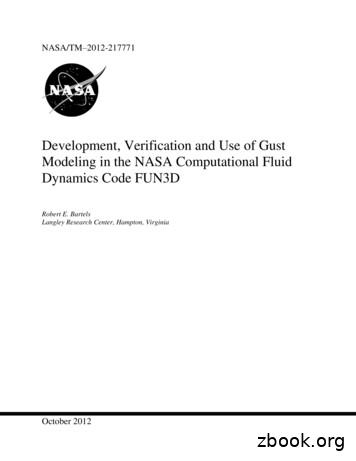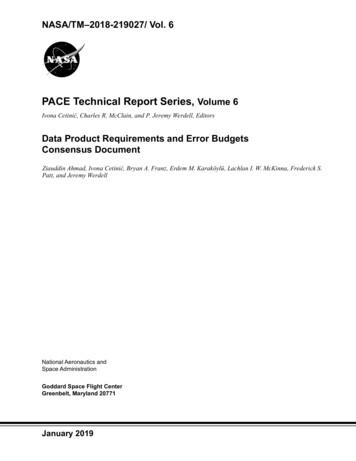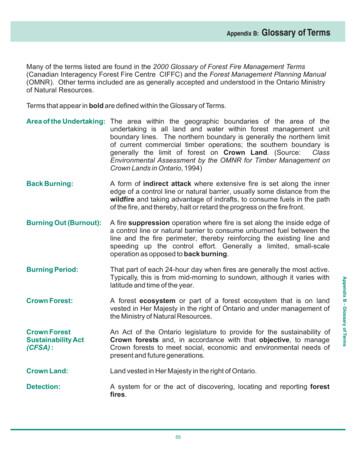FIRE PROTECTION PROGRAM - NASA
LPR 1710.11Effective Date: October 3, 2004Expiration Date:Langley Research CenterFIRE PROTECTION PROGRAMNational Aeronautics and Space AdministrationThis Document is Uncontrolled When Printed.Check the LMS web site to verify that this is the correct version before use.June 21, 2009
October 3, 2004LPR 1710.11RESPONSIBLE OFFICE: SAFETY AND MISSION ASSURANCE OFFICEPREFACEP.1PURPOSEThis Langley Procedural Requirements (LPR) sets forth procedural requirements for theLangley Research Center (LaRC) Fire Protection Program. It defines the requirementsof the Center’s Fire Protection Program. This program includes the elements ofmanagement; administration; documentation; training; system facility design andconstruction; fire protection engineering; fire prevention; annunciation; confinement;suppression; fire department; inspection, testing, and maintenance; and qualityassurance. This LPR also provides guidance for government personnel in performingtheir responsibilities for this program.P.2APPLICABILITYThis directive is applicable to all employees at LaRC.P.3AUTHORITYa.NPD 8700.1, "NASA Policy for Safety and Mission Success"b.NPD 8710.2, "Safety and Health Program Policy"P.4REFERENCESa.NPR 8715.3, " NASA Safety Manual"b.STD 8719.11, "NASA Safety Standard for Fire Protection"c.NPR 8820.2, "Facility Project Implementation Handbook."d.29 CFR Part 1910 Subpart L, Fire Protectione.STD 8719.7, “Facility System Safety Manual”f.NFPA 101, “Life Safety Code”g.NFPA 70, “National Electrical Code”h.NFPA 1, “Fire Prevention Code”i.ASME A17.1, “Safety Code for Elevators”This Document is Uncontrolled When Printed.Check the LMS web site to verify that this is the correct version before use.
October 3, 2004P.5LPR 1710.11CANCELLATIONN/Aoriginal signed on fileRoy D. Bridges, Jr.DirectorDISTRIBUTION:SDL 040, SDL 043, SDL 4 1 0, SDL 41 1, and SDL 412429/SMAO (150 copies)This Document is Uncontrolled When Printed.Check the LMS web site to verify that this is the correct version before use.ii
October 3, 2004LPR 1710.11TABLE OF CONTENTSChapterPage1.INTRODUCTION . 1-11.1FORWARD. 1-11.2GLOSSARY OF TERMS . 1-22.PROGRAM MANAGEMENT. 2-12.1FIRE PROTECTION STATEMENT . 2-12.2FIRE PROTECTION ISSUES MANAGEMENT. 2-42.3FIRE PROTECTION DEVIATION AND WAVIERS . 2-72.4FIRE PROTECTION RULES. 2-83.ADMINISTRATIVE ASPECTS/FEATURES . 3-13.1FIRE PROTECTION PROGRAM ANNUAL REPORT . 3-13.2HALON EXTINGUISHING AGENT . 3-13.3FIRE PROTECTION ENGINEERING SURVEY DEFICIENCYDATABASE. 3-33.4FIRE PROTECTION ENGINEERING SURVEY DEFICIENCY RANKINGSYSTEM. 3-43.5FUNDING PRIORITIZATION OF FIRE PROTECTION ISSUES. 3-73.6PROCUREMENT RELATED FIRE PROTECTION ISSUES . 3-103.7AUTHORITY HAVING JURISDICTION . 3-113.8FIRE INVESTIGATION AND REPORTING. 3-134.DESIGN CRITERIA. 4-14.1FIRE PROTECTION DESIGN CRITERIA . 4-14.2PROPERTY LOSS DESIGN CRITERIA. 4-24.3FACILITY MODIFICATIONS AFFECTING FIRE PROTECTIONAND/OR LIFE SAFETY ASPECTS. 4-44.4FIRE PROTECTION DESIGN/DOCUMENT REVIEW PROCESS . 4-65.FIRE PROTECTION EQUIPMENT AND SYSTEMS (OPERATIONS ANDRELIABILITY) . 5-15.1FIRE PROTECTION SYSTEM IMPAIRMENTS . 5-15.2UTILITY IMPAIRMENTS AFFECTING FIRE PROTECTION SYSTEMS . 5-35.3FIRE PROTECTION SYSTEM WINTERIZATION. 5-45.4NONEMERGENCY USE OF FIRE HYDRANTS . 5-65.5INSPECTION, TESTING, AND MAINTENANCE DOCUMENTATIONREVIEW AND ANALYSIS. 5-65.6INSPECTION, TESTING, AND, MAINTENANCE MATRIX . 5-86.LIFE SAFETY. 6-16.1MEANS OF EGRESS. 6-16.2FACILITY EVACUATION PLANS. 6-26.3FACILITY EMERGENCY LIGHTS . 6-56.4OCCUPANCY PERMIT APPROVAL . 6-5This Document is Uncontrolled When Printed.Check the LMS web site to verify that this is the correct version before use.iii
October 3, 2004LPR 1710.11TABLE OF CONTENTS (Cont.)ChapterPage7.FIRE PROTECTION. 7-17.1SMOKING REGULATIONS . 7-17.2FIRE LANES . 7-17.3HOT WORK/OPEN FLAME AND WELDING PERMIT SYSTEM . 7-37.4FACILITY FIRE WATCH REQUIREMENTS . 7-67.5HEAT-PRODUCING APPLIANCES. 7-87.6FIRE PROTECTION DURING CONSTRUCTION . 7-117.7STANDARD FIRE SYMBOLS FOR LARC . 7-127.8CONTROL OF COMBUSTIBLES . 7-167.9HOUSEKEEPING PRACTICES TO MINIMIZE FIRE LOSS . 7-187.10 FIRE NOTIFICATION/FACILITY EVACUATION . 7-217.11 EMPLOYEE FIRE PROTECTION TRAINING. 7-247.12 FIRE PROTECTION IN FACILITY OPERATING PROCEDURES. 7-248.FIRE HAZARD PROTECTION. 8-18.1ELECTRICAL INSTALLATION IN HAZARDOUS LOCATIONS . 8-18.2FLAMMABLE AND COMBUSTIBLE LIQUIDS . 8-28.3SAFE STORAGE AND USE OF FLAMMABLE GASES . 8-48.4FIRE PROTECTION FOR PORTABLE STRUCTURES . 8-68.5FIRE PROTECTION FOR STORAGE FACILITIES AND AREAS . 8-108.6FIRE PROTECTION FOR COMBUSTIBLE SOLIDS, METALS,AND DUSTS. 8-128.7FIRE PROTECTION FOR CLEAN ROOMS. 8-148.8FIRE PROTECTION FOR AIRCRAFT HANGERS ERROR! BOOKMARK NOTDEFINED.8.9FIRE PROTECTION FOR FLIGHT SIMULATORS. 8-168.10 FIRE PROTECTION FOR COMPUTER FACILITIES . 8-188.11 FIRE PROTECTION FOR ANECHOIC CHAMBERS. 8-198.12 FIRE PROTECTION FOR TEMPORARY ENCLOSURES ANDMEMBRANE STRUCTURES . 8-238.13 FIRE PROTECTION FOR VITAL RECORDS STORAGE. 8-258.14 FIRE PROTECTION FOR OVENS, FURNACES, ANDENVIRONMENTAL CHAMBERS. 8-268.15 FIRE PROTECTION FOR HEPA FILTER SYSTEMS . 8-288.16 FIRE PROTECTION FOR HAZARDOUS MATERIALS STORAGE . 8-298.17 FIRE PROTECTION FOR LABORATORY FACILITIES. 8-308.18 FIRE PROTECTION FOR VACANT FACILITIES . 8-329.ASSESSMENT AND ANALYSIS . 9-19.1FIRE PROTECTION ENGINEERING SURVEY PROGRAM. 9-19.2FIRE HAZARD ANALYSIS PROGRAM. 9-29.3FIRE PROTECTION PROGRAM REVIEW/SELF-ASSESSMENT . 9-5This Document is Uncontrolled When Printed.Check the LMS web site to verify that this is the correct version before use.iv
October 3, 2004LPR 1710.11TABLE OF CONTENTS (Cont.)ChapterPage10. FIRE DEPARTMENT OPERATIONS AND EMERGENCY RESPONSE . 10-110.1 FIRE DEPARTMENT EMERGENCY EQUIPMENT . 10-110.2 FIRE DEPARTMENT PERSONAL PROTECTIVE EQUIPMENT. 10-210.3 FIRE FIGHTING FORCES . 10-310.4 FIRE SUPPRESSION . 10-410.5 FIRE DEPARTMENT TRAINING . 10-610.6 FIRE DEPARTMENT MUTUAL AID AGREEMENTS . 10-810.7 FIRE DEPARTMENT FACILITY INSPECTIONS . 10-810.8 EMERGENCY MEDICAL SERVICES . 10-910.9 FIRE DEPARTMENT PREPLANS . 10-910.10 FIRE DEPARTMENT HAZARDOUS MATERIAL RESPONSEPROGRAM. 10-1110.11 FIRE DEPARTMENT SALVAGE PLANS . 10-11APPENDICESAppendixPageA. FORMAT FOR ANNUAL SUMMARY OF FIRE AND OTHERPROPERTY DAMAGE EXPERIENCE REPORT . A-1B. FPE SURVEY DEFICIENCY DATABASE PRINTOUT . B-1C. FIRE PROTECTION IMPAIRMENT . C-1This Document is Uncontrolled When Printed.Check the LMS web site to verify that this is the correct version before use.v
October 3, 2004LPR 1710.11LIST OF FIGURESPageFIGURE 2.1,FUNCTIONAL/ORGANIZATIONAL STRUCTURE OF THE FIREPROTECTION PROGRAM . 2-2FIGURE 3.1,FIRE PROTECTION RATING SCHEDULE . 3-6FIGURE 3.2,FIRE PROTECTION FUNDING PRIORITIZATION SCORINGMATRIX . 3-10FIGURE 6.1,SAMPLE FACILITY EVACUATION PLAN. 6-4FIGURE 7.1,APPROVED FIRE LANE TURN AROUNDS . 7-3FIGURE 7.2,OUTSIDE FIRE PROTECTION EQUIPMENT SIGNAGE . 7-15This Document is Uncontrolled When Printed.Check the LMS web site to verify that this is the correct version before use.vi
October 3, 2004LPR 1710.11LIST OF TABLESPageTABLE 5.1,INSPECTING, TESTING, AND MAINTAINING: FIRE DOORSAND DAMPERS. 5-9TABLE 5.2,INSPECTING, TESTING, AND MAINTAINING: VALVES ANDFIRE DEPARTMENT CONNECTIONS . 5-10TABLE 5.3,INSPECTING, TESTING, AND MAINTAINING: DELUGE/WATERSPRAY FIXED SYSTEMS. 5-11TABLE 5.4,INSPECTING, TESTING, AND MAINTAINING: CARBONDIOXIDE SUPPRESSION SYSTEMS. 5-12TABLE 5.5,INSPECTING, TESTING, AND MAINTAINING: PORTABLEFIRE EXTINGUISHERS . 5-12TABLE 5.6,INSPECTING, TESTING, AND MAINTAINING: FIRE PUMPS. 5-13TABLE 5.7,INSPECTING, TESTING, AND MAINTAINING: PRIVATE FIRESERVICE MAINS . 5-13TABLE 5.8,INSPECTING, TESTING, AND MAINTAINING: STANDPIPEAND HOSE SYSTEMS . 5-14TABLE 5.9,INSPECTING, TESTING, AND MAINTAINING: FACILITYEMERGENCY LIGHTS . 5-14TABLE 5.10, INSPECTING, TESTING, AND MAINTAINING: WATERSTORAGE TANKS . 5-15TABLE 5.11, INSPECTING, TESTING, AND MAINTAINING: FIRE ALARMAND DETECTION SYSTEMS . 5-16TABLE 7.1,DEGREES OF HAZARDS. 7-14TABLE 8.1,SPRINKLERS FOR ANECHOIC CHAMBERS . 8-21This Document is Uncontrolled When Printed.Check the LMS web site to verify that this is the correct version before use.vii
October 3, 2004LPR 1710.11CHAPTER 11. INTRODUCTION1.1FORWARDLangley Research Center (LaRC) management is committed to strive for excellence inthe conduct of operations to ensure a fire-safe work environment. Work is performed atLaRC only when the risk of fire is as low as is reasonably achievable (ALARA) andwhen the people are provided with a fire-safe workplace. Facilities shall be designedand operated in a manner to minimize the adverse impacts of fire and its related perilsto workers, the public, and the environment. Fire protection support activities areconducted in compliance with fire safety laws, National Aeronautics and SpaceAdministration (NASA) directives, and regulations and general industry practices, and ina manner appropriate for the associated hazards.The establishment of a comprehensive LaRC fire protection program has as its goal toensure that an adequate level of fire protection and life safety is maintained forpersonnel and property. This LPR was developed in order to achieve this goal andmaintain a viable and effective fire safety program. Authority for the development andimplementation of the LaRC Fire Protection Program is rooted in two NASA-widepolicies: NPD 8700.1A, "NASA Policy for Safety and Mission Success" NPD 8710.2C, "Safety and Health Program Policy"Guidance for the development of this LPR was provided by: NPR 8715.3, " NASA Safety Manual" STD 8719.11, "NASA Safety Standard for Fire Protection" NPR 8820.2C, "Facility Project Implementation Handbook."NPR 8715.3 requires each NASA organizations to comply with the most currentrequirements of the following documents: Any applicable Federal Documents ICC International Codes (Building, Mechanical, Fire, Plumbing) 29 CFR Part 1910 Subpart L, Fire Protection Any applicable NASA Documents NASA Safety Standard for Fire Protection – STD 8719.11 Facility System Safety Manual – STD 8719.7 Any applicable NFPA Codes and Standards and their Appendices NFPA 101, Life Safety Code NFPA 70, National Electrical Code NFPA 1, Fire Prevention CodeThis Document is Uncontrolled When Printed.Check the LMS web site to verify that this is the correct version before use.1-1
October 3, 2004 LPR 1710.11ASME A17.1, Safety Code for ElevatorsSTD 8719.11 expands on the policy and guidelines for fire protection listed in NPR8715.3. STD 8719.11 is a compilation of pertinent requirements from OSHA, NFPA, aswell as unique NASA requirements. Compliance with this standard is mandatory for allNASA Field Installations. This Standard establishes fire protection requirements forNASA facilities in addition to those provided in NPR 8820.2C. NPR 8820.2C adds thefollowing documents to the list of those stated previously that must be adhered to: Code of Federal Regulations (CFR) Factory Mutual (FM) Data Sheets and Approval GuidesLaRC management is responsible for correcting work conditions and employee actionsthat may contribute to the occurrence of fire. It also is responsible for informingemployees, contractors, and relevant authorities of known potential fire hazardsencountered in the workplace; for training individuals and making equipment andappropriate job procedures available so that each assignment can be completed in afire-safe manner; and for ensuring that contractors apply fire protection requirementsfully complying with LaRC directives.1.2 GLOSSARY OF TERMSAging: Large-scale deterioration over time, caused by service and the environment.Approved: Acceptable to the Authority Having Jurisdiction (AHJ).Approved Materials: Materials approved by Factory Mutual (FM) or listed withUnderwriters Laboratories (UL).Assembly Point: An area identified by the facility owner and/or facility safety head withconcurrence from the LaRC Fire Chief for facility personnel to safely gather following anevacuation.Authority Having Jurisdiction (AHJ): The individual responsible for approving equipment,an installation, or a procedure.Building: Any structure, enclosure, facility, or ramp used or intended for supporting orsheltering any use or occupancy. The term “building” shall be construed as if followedby the words “or portions thereof.”Certificate of Beneficial Occupancy: A document signed by the Safety and FacilityAssurance Branch (SFAB) Head attesting that an area or facility substantially complieswith all fire protection and Life Safety Code requirements, but is not in literal compliancewith all fire safety requirements.Certificate of Final Occupancy: A document signed by the SFAB Head attesting that anarea or facility fully complies with applicable Occupational, Safety and HealthAdministration (OSHA), National Fire Protection Association (NFPA), NASA, and LaRCsafety requirements on the date of the issuance of the certificate.Clean Room: A room in which the concentration of airborne particles is controlled tospecific limits.This Document is Uncontrolled When Printed.Check the LMS web site to verify that this is the correct version before use.1-2
October 3, 2004LPR 1710.11Clean Zone: A defined space in which the concentration of airborne particles iscontrolled to specific limits.Computer Area: An area of a facility where the computer room is located includingsupport rooms served by the same special air conditioning/air handling equipment asthe computer room.Computer Room: A room within the computer area that contains the electroniccomputer/data processing equipment.Construction Projects: New facilities, facility additions, and facility alterations.Deviation: A variance that authorizes departure from a particular safety requirementwhere the intent of the requirement is being met through alternate means which providean equal or greater level of safety.Exit: That portion of a means of egress that is separated from all other spaces of thefacility or structure by construction or equipment as required by referenced documentsto provide a protected way of travel to the exit discharge.Exit Access: That portion of a means of egress that leads to an exit.Exit Discharge: That portion of a means of egress between the termination of an exitand the public way.Facility Fire Watch: The monitoring of facility operations during fire protection systemimpairments and the monitoring of other compensatory measures.Facility Owner and/or Facility Safety Head: The individual having either theresponsibility for all facility related items or processes with the facility or theresponsibility for the personnel working in the facility. The responsible manager is thefacility owner in instances where the requirement or responsibility pertains to the actualfacility or processes in the facility,
c. NPR 8820.2, "Facility Project Implementation Handbook." d. 29 CFR Part 1910 Subpart L, Fire Protection e. STD 8719.7, “Facility System Safety Manual” f. NFPA 101, “Life Safety Code” g. NFPA 70, “National Electrical Code” h. NFPA 1, “Fire Prevention Code” i. ASME A17
FIRE TOPPER Fire Bowl User Manual Home » FIRE TOPPER » FIRE TOPPER Fire Bowl User Manual Contents [ hide 1 FIRE TOPPER Fire Bowl 2 Setting Up Your Fire Topper Fire Bowl 2.1 Set-Up 3 Placement and Location 3.1 Liquid Propane Tank 4 Using your Fire Topper Fire Bowl - For your safety, read before lighting. 5 Cleaning, Maintenance, Storage 6 .
2016 nasa 0 29 nasa-std-8739.4 rev a cha workmanship standard for crimping, interconnecting cables, harnesses, and wiring 2016 nasa 0 30 nasa-hdbk-4008 w/chg 1 programmable logic devices (pld) handbook 2016 nasa 0 31 nasa-std-6016 rev a standard materials and processes requirements for spacecraft 2016 nasa 0 32
social or cultural context (livelihoods, festivals, traditional, conflict) and perhaps regulatory framework (permit fires, illegal fires). The terms include fires, wildfires, wildland fire, forest fire, grass fire, scrub fire, brush fire, bush fire, veldt fire, rural fire, vegetation fire and so on (IUFRO 2018). The European Forest Fire
Jan 10, 2012 · The NASA STI program provides access to the NASA Aeronautics and Space Database and its public interface, the NASA Technical Report Server, thus providing one of the largest collections of aeronautical and space science STI in the world. Results are published in both non-NASA channels and by NASA in the NASA
The NASA STI program provides access to the NASA Aeronautics and Space Database and its public interface, the NASA Technical Report Server, thus providing one of the largest collections of aero-nautical and space science STI in the world. Results are published in both non-NASA channels and by NASA in the NASA
The NASA STI program provides access to the NASA Aeronautics and Space Database and its public interface, the NASA Technical Report Server, thus providing one of the largest collections of aero-nautical and space science STI in the world. Results are published in both non-NASA channels and by NASA in the NASA STI Report Series, which includes
The NASA STI program provides access to the NASA Aeronautics and Space Database and its public interface, the NASA Technical Report Server, thus providing one of the largest collections of aero-nautical and space science STI in the world. Results are published in both non-NASA channels and by NASA in the NASA STI Report Series, which includes
Appendix B: Glossary of Terms A p p e n d i x B-G l o s s a r y o f T e r m s Fire Depletion Area Burned: Fire Impacts: Fire Intensity: Fire Load: Fire Management: Fire Management Zone: Fire Prevention: Fire Protection: Fire Regime: Fire Risk: Area burned that directly impacts wood supply to the forest industry. This could include allocated .























